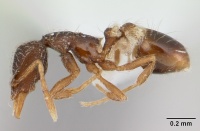Strumigenys tanymastax
| Strumigenys tanymastax | |
|---|---|

| |
| Scientific classification | |
| Kingdom: | Animalia |
| Phylum: | Arthropoda |
| Class: | Insecta |
| Order: | Hymenoptera |
| Family: | Formicidae |
| Subfamily: | Myrmicinae |
| Tribe: | Attini |
| Genus: | Strumigenys |
| Species: | S. tanymastax |
| Binomial name | |
| Strumigenys tanymastax (Brown, 1964) | |
Little is known about the biology of this species. A few workers were collected from litter sampling in dry chaco.
Identification
The only member of the Strumigenys tanymastax-group.
Keys including this Species
Distribution
Latitudinal Distribution Pattern
Latitudinal Range: -22.571° to -28.667°.
| North Temperate |
North Subtropical |
Tropical | South Subtropical |
South Temperate |
- Source: AntMaps
Distribution based on Regional Taxon Lists
Neotropical Region: Argentina, Brazil (type locality), Paraguay, Venezuela.
Distribution based on AntMaps
Distribution based on AntWeb specimens
Check data from AntWeb
Countries Occupied
| Number of countries occupied by this species based on AntWiki Regional Taxon Lists. In general, fewer countries occupied indicates a narrower range, while more countries indicates a more widespread species. |

|
Estimated Abundance
| Relative abundance based on number of AntMaps records per species (this species within the purple bar). Fewer records (to the left) indicates a less abundant/encountered species while more records (to the right) indicates more abundant/encountered species. |

|
Biology
Castes
Nomenclature
The following information is derived from Barry Bolton's Online Catalogue of the Ants of the World.
- tanymastax. Smithistruma tanymastax Brown, 1964a: 183, pl. 16, fig. 1 (w.) BRAZIL. Combination in Pyramica: Bolton, 1999: 1673; in Strumigenys: Baroni Urbani & De Andrade, 2007: 128. See also: Bolton, 2000: 241.
Unless otherwise noted the text for the remainder of this section is reported from the publication that includes the original description.
Description
Worker
Bolton (2000) - TL 1.6-1.8, HL 0.44-0.48, HW 0.30-0.33, CI 68-71, ML 0.11-0.12, MI 25-27, SL 0.25-0.28, SI 82-88, PW 0.20-0.24, AL 0.43-0.47 (4 measured).
Apicoscrobal hair long, fine and flagellate; cephalic dorsum above apicoscrobal hair with an erect elongate fine hair that is quite distinct from the ground-pilosity. Ground-pilosity of cephalic dorsum of long curved hairs that are simple to narrowly spatulate, much longer and narrower than those on the clypeus. Eye with 3-6 ommatidia in total. Dorsum of head and alitrunk, and declivity of propodeum, reticulate-punctate. Pleurae and side of propodeum smooth and shining. Ground-pilosity of dorsal alitrunk of long medially-curved hairs, the mesonotum also with a pair of very long fine flagellate hairs. Fine curved to flagellate hairs also occur on dorsal surfaces of waist segments and first gastral tergite. Dorsal (outer) surfaces of hind tibiae with narrowly spatulate curved hairs that are all directed toward the apex. Petiole node weakly punctate dorsally, broader than long; postpetiole much broader than long and glassy smooth. Basigastral costulae sharply defined and evenly spaced, the tergite between and behind them smooth and shining.
Type Material
Bolton (2000) - Holotype worker, BRAZIL: Santa Catarina, Nova Teutonia, 300-500 m., (F. Plaumann) Museu de Zoologia da Universidade de Sao Paulo; paratype worker, BRAZIL: SC, Chapecó, v. 1957 (F. Plaumann) Museum of Comparative Zoology. [examined].
References
- Baroni Urbani, C. & De Andrade, M.L. 2007. The ant tribe Dacetini: limits and constituent genera, with descriptions of new species. Annali del Museo Civico di Storia Naturale “G. Doria”. 99:1-191.
- Bolton, B. 1999. Ant genera of the tribe Dacetonini (Hymenoptera: Formicidae). J. Nat. Hist. 3 33:1639-1689 (page 1673, combination in Pyramica)
- Bolton, B. 2000. The ant tribe Dacetini. Mem. Am. Entomol. Inst. 65: 1-1028 (page 241, figs. 161, 194 worker described)
- Brown, W. L., Jr. 1964b. The ant genus Smithistruma: a first supplement to the World revision (Hymenoptera: Formicidae). Trans. Am. Entomol. Soc. 89:183-200. (page 183, pl. 16, fig. 1 worker described)
- Kempf, W. W. 1972b. Catálogo abreviado das formigas da regia~o Neotropical. Stud. Entomol. 15:3-344 (page 211, catalogue)
References based on Global Ant Biodiversity Informatics
- Bolton B. 1999. Ant genera of the tribe Dacetonini (Hymenoptera: Formicidae). Journal of Natural History 33: 1639-1689.
- Bolton, B. 2000. The Ant Tribe Dacetini. Memoirs of the American Entomological Institute 65
- Brown W. L. 1964. The ant genus Smithistruma: a first supplement to the world revision (Hymenoptera: Formicidae). Transactions of the American Entomological Society 89: 183-200.
- Calixto J. M. 2013. Lista preliminar das especies de formigas (Hymenoptera: Formicidae) do estado do Parana, Brasil. Universidad Federal do Parana 34 pages.
- Favretto M. A., E. Bortolon dos Santos, and C. J. Geuster. 2013. Entomofauna from West of Santa Catarina State, South of Brazil. EntomoBrasilis 6 (1): 42-63.
- Fernández, F. and S. Sendoya. 2004. Lista de las hormigas neotropicales. Biota Colombiana Volume 5, Number 1.
- Kempf W. W. 1978. A preliminary zoogeographical analysis of a regional ant fauna in Latin America. 114. Studia Entomologica 20: 43-62.
- Kempf, W.W. 1972. Catalago abreviado das formigas da regiao Neotropical (Hym. Formicidae) Studia Entomologica 15(1-4).
- Medeiros Macedo L. P., E. B. Filho, amd J. H. C. Delabie. 2011. Epigean ant communities in Atlantic Forest remnants of São Paulo: a comparative study using the guild concept. Revista Brasileira de Entomologia 55(1): 7578.
- Rosa da Silva R. 1999. Formigas (Hymenoptera: Formicidae) do oeste de Santa Catarina: historico das coletas e lista atualizada das especies do Estado de Santa Catarina. Biotemas 12(2): 75-100.
- Silva R.R., and C. R. F. Brandao. 2014. Ecosystem-Wide Morphological Structure of Leaf-Litter Ant Communities along a Tropical Latitudinal Gradient. PLoSONE 9(3): e93049. doi:10.1371/journal.pone.0093049
- Suguituru S. S., M. Santina de Castro Morini, R. M. Feitosa, and R. Rosa da Silva. 2015. Formigas do Alto Tiete. Canal 6 Editora 458 pages
- Ulyssea M. A., C. R. F. Brandao. 2013. Catalogue of Dacetini and Solenopsidini ant type specimens (Hymenoptera, Formicidae, Myrmicinae) deposited in the Museu de Zoologia da Universidade de Sao Paulo, Brazil. Papies Avulsos de Zoologia 53(14): 187-209.

